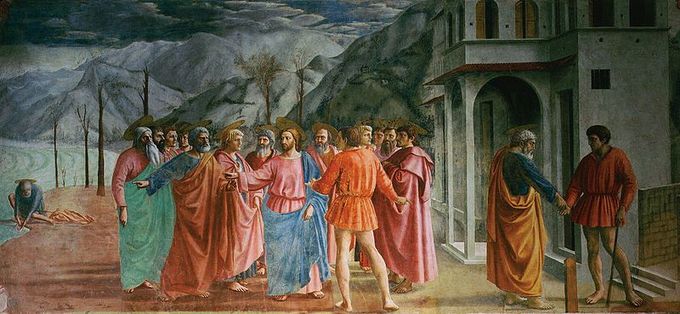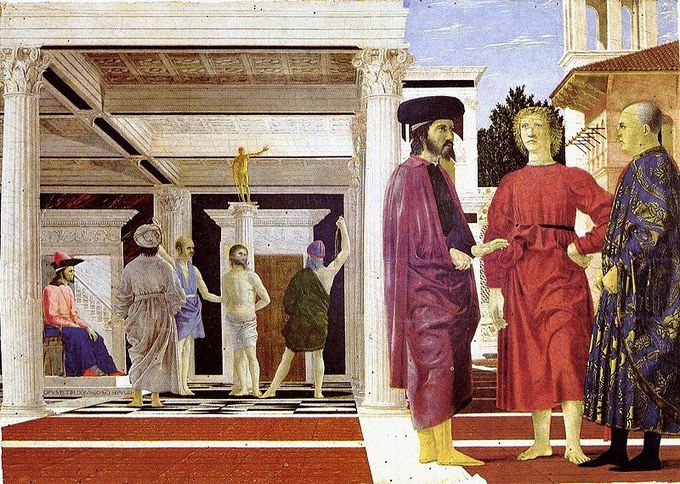19.4: Renaissance Painting
- Page ID
- 53060
\( \newcommand{\vecs}[1]{\overset { \scriptstyle \rightharpoonup} {\mathbf{#1}} } \)
\( \newcommand{\vecd}[1]{\overset{-\!-\!\rightharpoonup}{\vphantom{a}\smash {#1}}} \)
\( \newcommand{\dsum}{\displaystyle\sum\limits} \)
\( \newcommand{\dint}{\displaystyle\int\limits} \)
\( \newcommand{\dlim}{\displaystyle\lim\limits} \)
\( \newcommand{\id}{\mathrm{id}}\) \( \newcommand{\Span}{\mathrm{span}}\)
( \newcommand{\kernel}{\mathrm{null}\,}\) \( \newcommand{\range}{\mathrm{range}\,}\)
\( \newcommand{\RealPart}{\mathrm{Re}}\) \( \newcommand{\ImaginaryPart}{\mathrm{Im}}\)
\( \newcommand{\Argument}{\mathrm{Arg}}\) \( \newcommand{\norm}[1]{\| #1 \|}\)
\( \newcommand{\inner}[2]{\langle #1, #2 \rangle}\)
\( \newcommand{\Span}{\mathrm{span}}\)
\( \newcommand{\id}{\mathrm{id}}\)
\( \newcommand{\Span}{\mathrm{span}}\)
\( \newcommand{\kernel}{\mathrm{null}\,}\)
\( \newcommand{\range}{\mathrm{range}\,}\)
\( \newcommand{\RealPart}{\mathrm{Re}}\)
\( \newcommand{\ImaginaryPart}{\mathrm{Im}}\)
\( \newcommand{\Argument}{\mathrm{Arg}}\)
\( \newcommand{\norm}[1]{\| #1 \|}\)
\( \newcommand{\inner}[2]{\langle #1, #2 \rangle}\)
\( \newcommand{\Span}{\mathrm{span}}\) \( \newcommand{\AA}{\unicode[.8,0]{x212B}}\)
\( \newcommand{\vectorA}[1]{\vec{#1}} % arrow\)
\( \newcommand{\vectorAt}[1]{\vec{\text{#1}}} % arrow\)
\( \newcommand{\vectorB}[1]{\overset { \scriptstyle \rightharpoonup} {\mathbf{#1}} } \)
\( \newcommand{\vectorC}[1]{\textbf{#1}} \)
\( \newcommand{\vectorD}[1]{\overrightarrow{#1}} \)
\( \newcommand{\vectorDt}[1]{\overrightarrow{\text{#1}}} \)
\( \newcommand{\vectE}[1]{\overset{-\!-\!\rightharpoonup}{\vphantom{a}\smash{\mathbf {#1}}}} \)
\( \newcommand{\vecs}[1]{\overset { \scriptstyle \rightharpoonup} {\mathbf{#1}} } \)
\( \newcommand{\vecd}[1]{\overset{-\!-\!\rightharpoonup}{\vphantom{a}\smash {#1}}} \)
\(\newcommand{\avec}{\mathbf a}\) \(\newcommand{\bvec}{\mathbf b}\) \(\newcommand{\cvec}{\mathbf c}\) \(\newcommand{\dvec}{\mathbf d}\) \(\newcommand{\dtil}{\widetilde{\mathbf d}}\) \(\newcommand{\evec}{\mathbf e}\) \(\newcommand{\fvec}{\mathbf f}\) \(\newcommand{\nvec}{\mathbf n}\) \(\newcommand{\pvec}{\mathbf p}\) \(\newcommand{\qvec}{\mathbf q}\) \(\newcommand{\svec}{\mathbf s}\) \(\newcommand{\tvec}{\mathbf t}\) \(\newcommand{\uvec}{\mathbf u}\) \(\newcommand{\vvec}{\mathbf v}\) \(\newcommand{\wvec}{\mathbf w}\) \(\newcommand{\xvec}{\mathbf x}\) \(\newcommand{\yvec}{\mathbf y}\) \(\newcommand{\zvec}{\mathbf z}\) \(\newcommand{\rvec}{\mathbf r}\) \(\newcommand{\mvec}{\mathbf m}\) \(\newcommand{\zerovec}{\mathbf 0}\) \(\newcommand{\onevec}{\mathbf 1}\) \(\newcommand{\real}{\mathbb R}\) \(\newcommand{\twovec}[2]{\left[\begin{array}{r}#1 \\ #2 \end{array}\right]}\) \(\newcommand{\ctwovec}[2]{\left[\begin{array}{c}#1 \\ #2 \end{array}\right]}\) \(\newcommand{\threevec}[3]{\left[\begin{array}{r}#1 \\ #2 \\ #3 \end{array}\right]}\) \(\newcommand{\cthreevec}[3]{\left[\begin{array}{c}#1 \\ #2 \\ #3 \end{array}\right]}\) \(\newcommand{\fourvec}[4]{\left[\begin{array}{r}#1 \\ #2 \\ #3 \\ #4 \end{array}\right]}\) \(\newcommand{\cfourvec}[4]{\left[\begin{array}{c}#1 \\ #2 \\ #3 \\ #4 \end{array}\right]}\) \(\newcommand{\fivevec}[5]{\left[\begin{array}{r}#1 \\ #2 \\ #3 \\ #4 \\ #5 \\ \end{array}\right]}\) \(\newcommand{\cfivevec}[5]{\left[\begin{array}{c}#1 \\ #2 \\ #3 \\ #4 \\ #5 \\ \end{array}\right]}\) \(\newcommand{\mattwo}[4]{\left[\begin{array}{rr}#1 \amp #2 \\ #3 \amp #4 \\ \end{array}\right]}\) \(\newcommand{\laspan}[1]{\text{Span}\{#1\}}\) \(\newcommand{\bcal}{\cal B}\) \(\newcommand{\ccal}{\cal C}\) \(\newcommand{\scal}{\cal S}\) \(\newcommand{\wcal}{\cal W}\) \(\newcommand{\ecal}{\cal E}\) \(\newcommand{\coords}[2]{\left\{#1\right\}_{#2}}\) \(\newcommand{\gray}[1]{\color{gray}{#1}}\) \(\newcommand{\lgray}[1]{\color{lightgray}{#1}}\) \(\newcommand{\rank}{\operatorname{rank}}\) \(\newcommand{\row}{\text{Row}}\) \(\newcommand{\col}{\text{Col}}\) \(\renewcommand{\row}{\text{Row}}\) \(\newcommand{\nul}{\text{Nul}}\) \(\newcommand{\var}{\text{Var}}\) \(\newcommand{\corr}{\text{corr}}\) \(\newcommand{\len}[1]{\left|#1\right|}\) \(\newcommand{\bbar}{\overline{\bvec}}\) \(\newcommand{\bhat}{\widehat{\bvec}}\) \(\newcommand{\bperp}{\bvec^\perp}\) \(\newcommand{\xhat}{\widehat{\xvec}}\) \(\newcommand{\vhat}{\widehat{\vvec}}\) \(\newcommand{\uhat}{\widehat{\uvec}}\) \(\newcommand{\what}{\widehat{\wvec}}\) \(\newcommand{\Sighat}{\widehat{\Sigma}}\) \(\newcommand{\lt}{<}\) \(\newcommand{\gt}{>}\) \(\newcommand{\amp}{&}\) \(\definecolor{fillinmathshade}{gray}{0.9}\)Renaissance Painting: Masaccio
Renaissance painting was developed in 15th century Florence when artists began to reject the flatness of Gothic painting and strive toward greater naturalism.
Discuss the important 15th century Florentine artists and the techniques they used
Key Points
- Florentine painting received a new lease on life in the early 15th century, when the use of perspective was formalized by the architect Filippo Brunelleschi and adopted by painters as an artistic technique.
- Other important techniques developed in Florence during the first half of the 15th century include the use of realistic proportions, foreshortening , sfumato , and chiaroscuro .
- The artist most widely credited with first popularizing these techniques in 15th century Florence is Masaccio (1401–1428), the first great painter of the Quattrocento period of the Italian Renaissance .
- Masaccio was deeply influenced both by Giotto’s earlier innovations in solidity of form and naturalism and Brunelleschi’s formalized use of perspective in architecture and sculpture , and moved away from the International Gothic style to a more realistic mode.
- Masaccio is best known for his frescoes in the Brancacci Chapel, in which he employed techniques of linear perspective, such as the vanishing point for the first time, and had a profound influence on other artists despite the brevity of his career.
Key Terms
- vanishing point: The point in a perspective drawing at which parallel lines receding from an observer seem to converge.
- quattrocento: Renaissance Italian period during the 1400s.
Fifteenth century Florence was the birthplace of Renaissance painting, which rejected the flatness and stylized nature of Gothic art in order to focus on naturalistic representations of the human body and landscapes. While Giotto is often referred to as the herald of the Renaissance, there was a break in artistic developments in Italy after his death, due largely to the Black Death . However, Florentine painting was revitalized the early 15th century, when the use of perspective was formalized by the architect Filippo Brunelleschi and adopted by painters as an artistic technique. The development of perspective was part of a wider trend towards realism in the arts.
Many other important techniques commonly associated with Renaissance painting developed in Florence during the first half of the 15th century, including the use of realistic proportions, foreshortening (the artistic effect of shortening lines in a drawing to create the illusion of depth), sfumato (the blurring of sharp outlines by subtle and gradual blending to give the illusion of three-dimensionality), and chiaroscuro (the contrast between light and dark to convey a sense of depth).
The artist most widely credited with first pioneering these techniques in 15th century Florence is Masaccio (1401–1428), the first great painter of the Quattrocento period of the Italian Renaissance. Masaccio was deeply influenced by both Giotto’s earlier innovations in solidity of form and naturalism and Brunelleschi’s formalized use of perspective in architecture and sculpture. Masaccio is best known for his frescoes in the Brancacci Chapel, in which he employed techniques of linear perspective such as the vanishing point for the first time, and had a profound influence on other artists despite the brevity of his career.
Masaccio was friends with Brunelleschi and the sculptor Donatello, and collaborated frequently with the older and already renowned artist Masolino da Panicale (1383/4–1436) who traveled with him to Rome in 1423. From this point onwards, he eschewed the Byzantine and Gothic styles altogether, adopting traces of influence from ancient Greek and Roman art instead. These are evident in the cycle of frescoes he executed alongside Masolino for the Brancacci Chapel in the church of Santa Maria del Carmine in Florence. The two artists started working on the chapel in 1425, but their work was completed by Filippo Lippi in the 1480s.
The frescoes in their entirety represent the story of human sin and redemption from the fall of Adam and Eve to the works of St. Peter. Giotto’s influence is evident in Masaccio’s frescoes, particularly in the weight and solidity of his figures and the vividness of their expressions. Unlike Giotto, Masaccio utilized linear and atmospheric perspective , and made even greater use of directional light and the chiaroscuro technique, enabling him to create even more convincingly lifelike paintings than his predecessor. His style and techniques became profoundly influential after his death and were imitated by his successors.

Renaissance Painting After Masaccio
After Masaccio’s death Florentine artists built on his contributions to the use of perspective and light and shadow.
Discuss the contribution of Masaccio to Renaissance art and his influence on painters of the Florentine Quattrocento
Key Points
- Florentine painting greatly increased in range and richness after Masaccio’s death, and 15th century artists adopted his drive towards naturalism and his use of linear perspective , as well as the sfumato and chiaroscuro techniques.
- The most famous Florentine Quattrocento painters of the post-Masaccio period were Paolo Uccello, Piero della Francesca, and Filippo Lippi, who dedicated themselves to the study of light and shadow and perspective as their paramount concern.
- Piero della Francesca studied light and linear perspective from a scientific point of view and wrote treatises about his findings.
- Paolo Uccello used foreshortening to give his work depth and also made use of light, color, and contrast to add to the drama of his painting.
Key Terms
- humanism: Specifically, a cultural and intellectual movement prominent from the 14th to 16th centuries in Europe characterized by attention to classical culture and a promotion of vernacular texts, notably during the Renaissance.
- chiaroscuro: An artistic technique popularized during the Renaissance, referring to the use of exaggerated light contrasts in order to create the illusion of volume.
- sfumato: In painting, the application of subtle layers of translucent paint so that there is no visible transition between colors, tones, and often objects.
Masaccio is widely regarded as the first Renaissance painter of the Italian Quattrocento, and despite the brevity of his career, had the most profound influence on his successors. Florentine painting greatly increased in range and richness after Masaccio’s death. Fifteenth century artists adopted and built on the style and techniques that he had introduced to Italian painting, most notably the drive towards naturalism and the use of linear perspective, sfumato, and chiaroscuro. Artists also began to focus even more on proportional and anatomically accurate representations of the human body and naturalistic landscapes.
Some of the most well known Florentine Quattrocento painters of the post-Masaccio period were Paolo Uccello (1397–1475), Piero della Francesca (1415–1492), and Fra Filippo Lippi (1406–1469). These painters dedicated themselves to the study of light and shadow and perspective as their paramount concern. Paolo Uccello was said to be so obsessed with trying to achieve the appearance of perspective by grasping the exact vanishing point that it disturbed his sleep. Piero della Francesca studied light and linear perspective from a scientific point of view and wrote treatises about his findings. These artists are usually referred to as the “Perfect Artists” for their precise and technical use of perspective in their works.
Paolo Uccello’s paintings emphasized color and pageantry rather than strictly classical realism , and he used perspective to convey a feeling of depth rather than to narrate different or succeeding stories as his contemporaries did. He is best known for his three egg tempera on wood paintings representing the Battle of San Romano, which use broken weapons on the ground and fields on the distant hills to show of his perfect employment of perspective and play of the idea of the checkerboard floor. Paolo Uccello also used light and contrast for dramatic effect in some of his almost monochrome frescoes , enlivening terra verde or “green earth” compositions with touches of bright vermilion. The best known is his equestrian portrait of John Hawkwood in the Florence Cathedral , which gives the impression of being lit by natural light as if the light source was an actual window in the cathedral.

Piero della Francesca is well known for his fresco paintings including the cycle of frescoes depicting the Legend of the True Cross. His paintings are characterized by its serene humanism and its use of geometric forms in addition to his close attention to perspective. His Flagellation of Christ demonstrates his mastery over linear perspective and his knowledge of how light is proportionally disseminated from its point of origin. The artist also includes a checkerboard floor in this work to show off his perfect use of perspective. There are two light sources in the painting, one inside the building and the other from outside. While the light source inside the building is invisible, its position can be calculated with mathematical certainty from the rest of the composition, demonstrating his intimate understanding of the science of light.

- Curation and Revision. Provided by: Boundless.com. License: CC BY-SA: Attribution-ShareAlike
- Masaccio7. Provided by: Wikipedia. Located at: en.Wikipedia.org/wiki/File:Masaccio7.jpg. License: Public Domain: No Known Copyright
- vanishing point. Provided by: Wiktionary. Located at: en.wiktionary.org/wiki/vanishing_point. License: CC BY-SA: Attribution-ShareAlike
- Italian Renaissance painting. Provided by: Wikipedia. Located at: en.Wikipedia.org/wiki/Italian_Renaissance_painting. License: CC BY-SA: Attribution-ShareAlike
- Masaccio. Provided by: Wikipedia. Located at: en.Wikipedia.org/wiki/Masaccio. License: CC BY-SA: Attribution-ShareAlike
- Italian renaissance. Provided by: Wikipedia. Located at: en.Wikipedia.org/wiki/Italian_renaissance. License: CC BY-SA: Attribution-ShareAlike
- Renaissance painting. Provided by: Wikipedia. Located at: en.Wikipedia.org/wiki/Renaissance_painting. License: CC BY-SA: Attribution-ShareAlike
- quattrocento. Provided by: Wiktionary. Located at: en.wiktionary.org/wiki/quattrocento. License: CC BY-SA: Attribution-ShareAlike
- Piero della Francesca 042 Flagellation. Provided by: Wikipedia. Located at: en.Wikipedia.org/wiki/File:Piero_della_Francesca_042_Flagellation.jpg. License: Public Domain: No Known Copyright
- Provided by: Wikimedia. Located at: upload.wikimedia.org/Wikipedia/commons/9/98/San_Romano_Battle_(Paolo_Uccello,_London)_01.jpg. License: Public Domain: No Known Copyright
- Italian Renaissance painting. Provided by: Wikipedia. Located at: en.Wikipedia.org/wiki/Italian_Renaissance_painting. License: CC BY-SA: Attribution-ShareAlike
- Renaissance painting. Provided by: Wikipedia. Located at: en.Wikipedia.org/wiki/Renaissance_painting. License: CC BY-SA: Attribution-ShareAlike
- chiaroscuro. Provided by: Wiktionary. Located at: en.wiktionary.org/wiki/chiaroscuro. License: CC BY-SA: Attribution-ShareAlike
- humanism. Provided by: Wiktionary. Located at: en.wiktionary.org/wiki/humanism. License: CC BY-SA: Attribution-ShareAlike
- sfumato. Provided by: Wiktionary. Located at: en.wiktionary.org/wiki/sfumato. License: CC BY-SA: Attribution-ShareAlike


